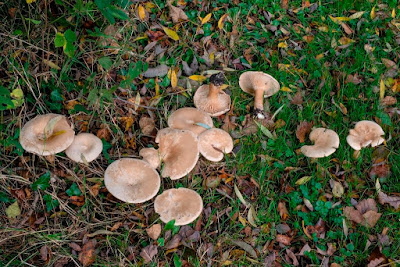Meadow Waxcap, Margam Park
Another conspicuous species which always occurs in large groups, often in roadside verges, is Trooping Funnel (Clitocybe geotropa). It's a tall, robust species, usually beige in colour. Mature specimens have the typical funnel shape exhibited by many Clitocybe species.
Trooping Funnel, Melincwrt roadside verge
Sand dunes are surprisingly good places to look for fungi and our local coastal systems have a very diverse mixture of interesting species. One of the most beautiful is a type of Blewit named Lepista sordida (I don't know if it has a common name). It's similar to Wood Blewit (Lepista nuda), another species which occurs sometimes in grassland and on sand dunes, but it's smaller and has a much more intense lilac colour.
Lepista sordida, Baglan Dunes
Lepista sordida, showing gills
Whiteford Burrows is an excellent place to look for sand dune fungi.











